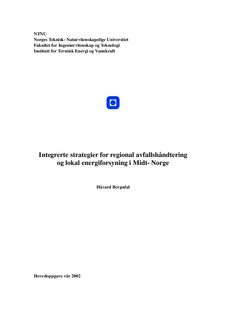| dc.contributor.author | Bergsdal, Håvard | nb_NO |
| dc.date.accessioned | 2014-12-19T12:31:04Z | |
| dc.date.available | 2014-12-19T12:31:04Z | |
| dc.date.created | 2007-03-02 | nb_NO |
| dc.date.issued | 2002 | nb_NO |
| dc.identifier | 122148 | nb_NO |
| dc.identifier.uri | http://hdl.handle.net/11250/242060 | |
| dc.description.abstract | Denne rapporten presenterer resultatene fra to ulike scenarier for energiutnyttelse av avfall i Midt- Norge- regionen. Resultatene baserer seg på LCA- metodikk, og vurderer scenariene ut fra deres totale potensielle miljøbelastninger i et tidsperspektiv som spenner fra år 2002 til år 2020. Hensikten er å synliggjøre områder hvor, og i hvilken grad, de to alternative løsningene skiller seg fra hverandre, samt vurdering av betydningen dette har ut fra den tilhørende forskjellen i potensiell miljøbelastning.
Scenariene skiller seg fra hverandre gjennom oppbyggingen av et regionalt system for fjernvarmeanlegg. I Scenario 1 foregår avfallsforbrenningen i større og mer sentraliserte anlegg, mens Scenario 2 bygger på lokal avfallsforbrenning ved utstrakt bruk av småskala fjernvarmeanlegg for behandling av både forbruks- og produksjonsavfall og spesialavfall. Scenariene skiller mellom forbrenningsteknologi og tilhørende utslipp.
Befolknings- og avfallsmengder er fremskrevet for hele regionen og for de enkelte eksisterende avfallsselskapene. Det samme er gjort for potensialet for utnyttelse av fjernvarme innad i regionen. Alle disse fremskrivningene er felles for de to scenariene, og utgjør grunnlaget for utarbeidelse disse.
Scenarienes miljøbelastning er vurdert ut fra deres potensiale for negativ miljøpåvirkning innenfor ulike påvirkningskategorier, som for eksempel “Globalt oppvarmingspotensiale”, “Menneskelig toksisitet” og “Forsuring” for å nevne noen. Resultater er gitt for hele scenariene, samt de enkelte delene i scenariene, og bidragene fra de ulike prosessene er vurdert.
Resultatene viser at det desentraliserte scenariet kommer til dels mye gunstigere ut innenfor alle påvirkningskategorier. Dette skyldes mindre utslipp pr. mengde behandlet avfall og et mye mindre transportbehov. Kostnadsoverslag for scenariene bekrefter resultatene og viser at miljøbelastning pr. innsatsfaktor er betraktelig høyere for det sentraliserte alternativet. Dette skyldes høyere utslipp fra avfallsbehandling og transport, samtidig som kostnadene knyttet til scenariene er på samme nivå. | nb_NO |
| dc.description.abstract | This report presents the results for two different scenarios for the explotation of energy produced by combustion of waste a region comprising the counties of Nord- Trøndelag, Sør- Trøndelag, Møre og Romsdal, together with parts of Nordland, Hedmark and Oppland. The results are based on LCA- methodology, and evaluate the scenarios on the basis of their total potential for causing environmental harm in a lifespan starting with the year 2002, and ending in 2020. The intention is to find out what parts, and to what extent, the alternative scenarios differ from each other, and to evaluate the significance this difference makes, regarding potential environmental harm.
The scenarios differ from each other by the construction of a regional system of district heating plants. The combustion of waste in Scenario 1 takes place in larger and more sentralized plants, while Scenario 2 is based on local combustion of waste by comprehensive use of smaller plants. The scenarios differ between combustion technology and the associating emissions.
Projections of population and generation of waste are calculated for the entire lifespan of the scenarios, for the region as a whole, and for individual parts of it. Projections are also made for the potential explotation of energy produced by district heating plants. The projections are all the same in both of the scenarios, and constituate the foundation for the creating these.
The environmental harm connected to the scenarios is evaluated by their potential influence on different impact categories, such as “Global warming potential”, “Human Toxicity” and “Acidification”, to name a few. Results are presented for the total scenarios, as well as the different parts of the systems, and contributions from the different processes are evaluated.
The results indicate that the desentralized scenario has much smaller contributions to the different impact categories than the sentralized scenario. The reason for this is less emissions pr. amount of waste and a much smaller demand for transportation. Cost estimates for the scenarios verify these results and shows that environmental burden pr. input is considerably larger the sentralized alternative. This is due to more emissions from the waste handling and transportation in this scenario, while the costs for the two scenarios are on approximately the same level. | nb_NO |
| dc.language | nor | nb_NO |
| dc.publisher | Norges teknisk-naturvitenskapelige universitet, Fakultet for ingeniørvitenskap og teknologi, Institutt for vann- og miljøteknikk | nb_NO |
| dc.title | Integrerte strategier for regional avfallshåndtering og lokal energiforsyning i Midt-Norge | nb_NO |
| dc.type | Master thesis | nb_NO |
| dc.contributor.department | Norges teknisk-naturvitenskapelige universitet, Fakultet for ingeniørvitenskap og teknologi, Institutt for vann- og miljøteknikk | nb_NO |
